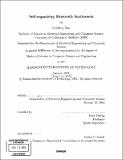Self-organizing Bluetooth scatternets
Author(s)
Tan, Godfrey, 1975-
DownloadFull printable version (5.177Mb)
Other Contributors
Massachusetts Institute of Technology. Dept. of Electrical Engineering and Computer Science.
Advisor
John Guttag.
Terms of use
Metadata
Show full item recordAbstract
There is increasing interest in wireless ad hoc networks built from portable devices equipped with short-range wireless network interfaces. This thesis addresses issues related to internetworking such networks to form larger "scatternets." Within the constraints imposed by the emerging standard Bluetooth link layer and MAC protocol, we develop a set of online algorithms to form scatternets and to schedule point-to-point communication links. Our efficient online topology formation algorithm, called TSF (Tree Scatternet Formation), builds scatternets by connecting nodes into a tree structure that simplifies packet routing and scheduling. Unlike earlier works, our design does not restrict the number of nodes in the scatternet, and also allows nodes to arrive and leave at arbitrary times, incrementally building the topology and healing partitions when they occur. We have developed a Bluetooth simulator in ns which includes most aspects of the entire Bluetooth protocol stack. It was used to derive simulation results that show that TSF has low latencies in link establishment, tree formation and partition healing. All of these grow logarithmically with the number of nodes in the scatternet. Furthermore, TSF generates tree topologies where the average path length between any node pair grows logarithmically with the size of the scatternet. Our scheduling algorithm, called TSS (Tree Scatternet Scheduling), takes advantage of the tree structure of the scatternets constructed by TSF. Unlike previous works, TSS coordinates one-hop neighbors effectively to increase the overall performance of the scatternet. In addition, TSS is robust and responsive to network conditions, adapting the inter-piconet link schedule effectively based on varying workload conditions. We demonstrate that TSS has good performance on throughput and latency under various traffic loads.
Description
Thesis (S.M.)--Massachusetts Institute of Technology, Dept. of Electrical Engineering and Computer Science, 2002. Includes bibliographical references (p. 71-73).
Date issued
2002Department
Massachusetts Institute of Technology. Department of Electrical Engineering and Computer SciencePublisher
Massachusetts Institute of Technology
Keywords
Electrical Engineering and Computer Science.